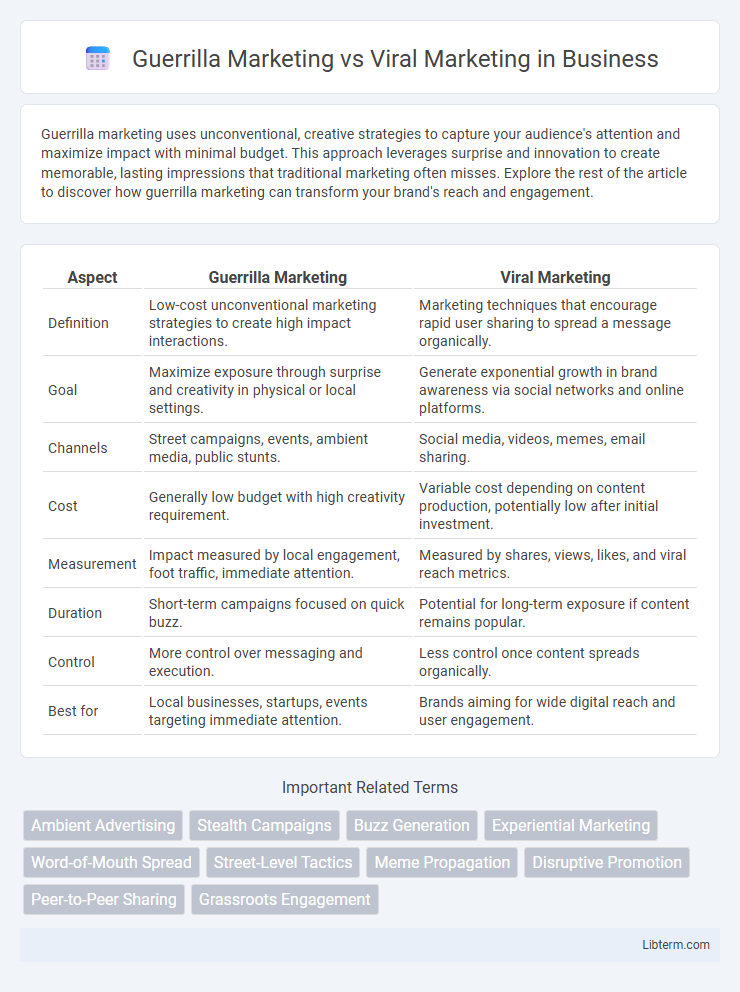Guerrilla marketing uses unconventional, creative strategies to capture your audience's attention and maximize impact with minimal budget. This approach leverages surprise and innovation to create memorable, lasting impressions that traditional marketing often misses. Explore the rest of the article to discover how guerrilla marketing can transform your brand's reach and engagement.
Table of Comparison
| Aspect | Guerrilla Marketing | Viral Marketing |
|---|---|---|
| Definition | Low-cost unconventional marketing strategies to create high impact interactions. | Marketing techniques that encourage rapid user sharing to spread a message organically. |
| Goal | Maximize exposure through surprise and creativity in physical or local settings. | Generate exponential growth in brand awareness via social networks and online platforms. |
| Channels | Street campaigns, events, ambient media, public stunts. | Social media, videos, memes, email sharing. |
| Cost | Generally low budget with high creativity requirement. | Variable cost depending on content production, potentially low after initial investment. |
| Measurement | Impact measured by local engagement, foot traffic, immediate attention. | Measured by shares, views, likes, and viral reach metrics. |
| Duration | Short-term campaigns focused on quick buzz. | Potential for long-term exposure if content remains popular. |
| Control | More control over messaging and execution. | Less control once content spreads organically. |
| Best for | Local businesses, startups, events targeting immediate attention. | Brands aiming for wide digital reach and user engagement. |
Understanding Guerrilla Marketing
Guerrilla marketing emphasizes unconventional, low-cost tactics designed to generate maximum exposure through creativity and surprise, often relying on street-level interactions and unique experiences. It targets local audiences with personalized campaigns that foster strong emotional connections and word-of-mouth referrals. This strategy contrasts viral marketing, which leverages digital platforms and social sharing to rapidly spread content globally with minimal direct engagement.
What is Viral Marketing?
Viral marketing is a strategy that leverages social networks and online platforms to rapidly spread a marketing message, aiming to achieve exponential growth through word-of-mouth sharing. It relies on compelling content, such as videos, memes, or challenges, that resonates emotionally, prompting users to share organically. Successful viral campaigns maximize audience engagement and brand visibility without the significant costs associated with traditional advertising.
Key Differences Between Guerrilla and Viral Marketing
Guerrilla marketing relies on unconventional, low-cost tactics to create memorable, local, or niche-targeted campaigns, often using physical spaces and direct audience interaction. Viral marketing focuses on creating highly shareable digital content designed to spread rapidly across social media platforms and reach a broad audience online. Key differences include guerrilla marketing's emphasis on surprise and personal engagement versus viral marketing's dependence on digital virality and network effects for exponential reach.
Core Strategies in Guerrilla Marketing
Guerrilla marketing centers on unconventional, low-cost tactics designed to create high-impact, memorable experiences that engage the target audience directly. Core strategies include leveraging surprise, creativity, and localized campaigns to generate buzz and word-of-mouth without relying on large advertising budgets. This approach contrasts viral marketing, which depends on digital sharing and online networks to achieve rapid content dissemination.
Essential Tactics in Viral Marketing
Viral marketing hinges on creating highly shareable and emotionally engaging content that encourages rapid user-to-user dissemination on social media platforms and digital channels. Essential tactics include leveraging influencers, crafting compelling storytelling, utilizing humor or surprise elements, and optimizing timing to align with audience behavior trends. Data-driven targeting and continuous analysis of engagement metrics further amplify a campaign's potential to achieve exponential reach and brand visibility.
Pros and Cons of Guerrilla Marketing
Guerrilla marketing offers cost-effective, creative campaigns that generate high engagement and memorable brand experiences, making it ideal for small businesses and startups. However, its reliance on unconventional tactics can sometimes lead to unpredictable results or legal issues if not carefully planned and executed. Although it fosters strong local impact and brand loyalty, guerrilla marketing often lacks the wide reach and rapid scalability associated with viral marketing strategies.
Pros and Cons of Viral Marketing
Viral marketing leverages social media and digital platforms to rapidly spread content, offering high engagement and potentially exponential reach at a low cost. Its key advantage lies in the ability to generate significant brand awareness and user-driven promotion without substantial advertising budgets. However, viral marketing risks include lack of control over content spread, potential for negative publicity, and unpredictability in achieving virality.
Successful Guerrilla Marketing Case Studies
Guerrilla marketing leverages unconventional, low-cost tactics to create memorable brand experiences, while viral marketing relies on content rapidly spreading through social networks. Successful guerrilla marketing case studies include Red Bull's "Stratos" space jump, which generated massive global media coverage and engagement, and IKEA's "Bedroom Store" pop-up in a subway station, creating immersive brand interactions. These campaigns effectively harness creativity and surprise to boost brand awareness and consumer engagement without relying solely on digital virality.
Memorable Viral Marketing Campaign Examples
Memorable viral marketing campaigns such as ALS Ice Bucket Challenge and Old Spice's "The Man Your Man Could Smell Like" harness emotional engagement and shareability to achieve massive organic reach. Unlike guerrilla marketing, which relies on unconventional, low-cost tactics to capture attention in physical spaces, viral marketing leverages digital platforms to rapidly spread compelling content across global audiences. Successful viral campaigns often combine humor, social relevance, and interactive elements to encourage widespread participation and brand visibility.
Choosing the Right Approach for Your Brand
Guerrilla marketing leverages unconventional, low-cost tactics to create memorable brand experiences, making it ideal for local or niche markets with limited budgets. Viral marketing relies on creating shareable, emotionally engaging content designed to spread rapidly across social media, best suited for brands targeting a broad, digitally connected audience. Selecting the right approach depends on your brand's budget, target demographic, and desired reach to maximize engagement and ROI.
Guerrilla Marketing Infographic

 libterm.com
libterm.com